

LOYAL • INTELLIGENT • BRAVE
and a wonderful disposition…
all wrapped up in a black & tan "package"!
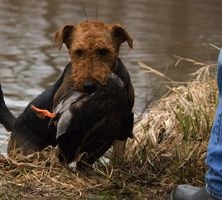
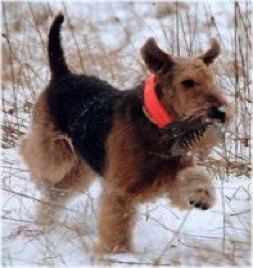
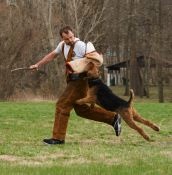
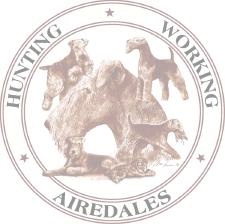
While some other breeds have distinct "field types" versus "show types," the Airedale Terrier Club of America maintains the belief that dogs bred to the conformation standard shouldn't differ from those dogs used for work or sport.
The ideal Airedale described in the breed's AKC Standard is a dog whose form follows its function as a strong and tireless working dog.
This space is too limited to reprint the entire Airedale standard, but a few points are pertinent. This, in part, is how the Airedale Standard describes the ideal Airedale:
Body: "Back should be short, strong, and level. Ribs well-sprung. Loins muscular and of good width. There should be little space between the last rib and the hip joint."
Hindquarters: "Should be strong and muscular with no droop."
Legs: "Forelegs should be perfectly straight, with plenty of muscle and bone."
Thighs: "Should be long and powerful with muscular second thigh, stifles well-bent, not turned either in or out, hocks well-let down parallel with each other when viewed from behind."
Coat: "Should be hard, dense and wiry, lying straight and close, covering the dog well over the body and legs. Some of the hardest are crinkling or just slightly waved. At the base of the hard very stiff hair should be a shorter growth of softer coat termed the undercoat."
Movement: "Movement or action is the crucial test of conformation. Movement should be free. As seen from the front, the forelegs should swing perpendicular from the body free from the sides, the feet the same distance apart as the elbows. As seen from the rear the hind legs should be parallel with each other, neither too close nor too far apart, but so placed as to give a strong well-balanced stance and movement. The toes should not be turned either in or out."
Eyes: "Dark, small, not prominent, full of terrier expression, keenness and intelligence."
The All-Purpose Airedale
The Working Airedale
Schutzhund (German for protection dog) is a dog sport which originated in Germany in the early 1900's as a breeding suitability test for the German shepherd dog and was quickly adopted for use by other working breeds such as the Malinois and Rottweiler. It provided breeders with a method to evaluate temperament, character, trainability, willingness and mental and physical soundness and to select and use only the highest quality dogs for breeding programs.
SCHUTZHUND
Though the word “Schutzhund” is recognized by many people, it is now an historical term since revised titles have supplanted it. In response to political forces in Germany, in 2004 the Verein für Deutsche Schäferhunde (SV) and the Deutscher Hundesportverein (DHV) made substantial changes to Schutzhund. The DHV adopted the Fédération Cynologique Internationale (FCI) rules that govern IPO titles, so that at least on paper the SV and DHV gave up control of the sport to the FCI. The DHV changed the name of the titles from "SchH" (Schutzhund) to "VPG" (Vielseitigkeitsprüfung für Gebrauchshunde which roughly translates Versatility examination for working dogs). Note DHV is equivalent to our AKC.*
There are three schutzhund titles:
Schutzhund 1 (SchH/VPG/IPO), Schutzhund 2 (SchH/VPG/IPO), and Schutzhund 3 (Sch/VPG/IPO).
SchH1 is the first title and SchH3 is the most advanced.
Additionally, before a dog can compete for a SchH1, he must pass a temperament test called a BH (Begleithundprüfung which translates as "traffic-sure companion dog test").
To obtain a title, the dog and handler must pass three distinct phases at a trial: tracking, obedience, and protection.
The Airedale competes at the very highest levels of international competition with the German Shepherd and Belgian Malinois, despite it's much smaller total population. This is the only breed to regularly do so.
Phase A: Tracking
In this phase, the dog must draw from inherited abilities by using his nose to find a person’s track and discover articles that have been dropped along the way. Unlike search & rescue where the dog relies primarily on “air-scenting”, Schutzhund tracking is very focused on the footsteps, and is scored largely on the precision of the dog’s performance. Depending upon the title sought, tracks will vary in length, shape and age. Tracking is usually done in dirt or on grass. A perfect score is 100 points, with a minimum of 70 needed to pass.
Phase B: Obedience
The obedience phase showcases the dog's inherent joy in the work balanced with precision and control. The exercises include heeling on and off leash, walking through a group of people, sit, down and/or stand while moving, recall, a 10+ minute long down while another dog is working on the field, retrieving, and jumping. Two shots are fired from a blank gun during the heeling and long down, and the dog must not react adversely. A set pattern is demonstrated by the handler with a perfect score being 100 points, with 70 needed to pass.
Phase C: Protection
In the protection work phase the dog must energetically locate and guard (without touching) a concealed criminal, prevent an escape by the criminal and stop a pursuing criminal. The dog is rated on self-confidence, ability to work under pressure, toughness and resilience, steadfast nerves, well-balanced drives and willingness to take directions and be responsive to the handler. Obedience and control are demonstrated throughout the protection phase through off-lead exercises and through guarding without biting.
A maximum 100 points are awarded for each of the three test phases, a passing score being 70 for tracking, 70 for obedience and 70 for protection. A 210 point total will earn a basic qualification degree, while higher scores of course are rewarded with more prestigious ratings and titles.
All VPG levels 1 to 3 test obedience tracking and protection at increasingly more complex and difficult levels. Thus it is similar to Junior, Senior, and Master in the HWA Hunt Tests, but the exception is all phases must be passed on the same day to earn a title. So as it is, an Airedale in the HWA program would have to get in a single day JHV, or SHV ~ and finally MHV.
Ohuivo’s Brisco, owned and handled by Dr. Edward Weiss of St. Louis, MO, is a VPG 3 dog who has also earned an FH, which is an advanced tracking title (beyond VPG 3 level tracking). In HWA hunts "Brisco" is JHV, SHF, and MHR. “Brisco” is the first and only Airedale and, probably, the only dog in the USA to be titled in both working sports and in hunting tests. This speaks to the versatility of the breed.
* It’s easy to confuse the terms DVG and VPG. VPG (versatility title for the test which requires obedience tracking and protection) while DVG is the organization, German Association of Working Dog Sport Clubs or "Deutscher Verband der Gebrauchshundsportvereine," that sponsors the test.
The VPG test is from what the new AKC working exam is derived.

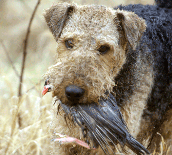
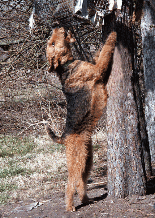
Click on the box above to visit the Working-dog.eu website – the worldwide largest site for active dog sportsmen, breeders and dog handlers.
Website created & maintained by Andrea Shaw
© 2016 ~ Hunting Working Airedales, Inc.
All rights reserved.
